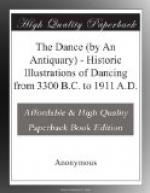[Illustration: Fig. 39.—Chamber dance, 15th century. From a drawing by Martin Zasinger.]
The stately out-door function, in a pleasure garden, from the “Roman de la Rose” (fig. 40) illustrates but one portion of the feature of a dance, another of which is described in Chaucer’s translation:
“They
threw y fere
Ther mouthes so that through
their play
It seemed as they kyste alway.”
Fancy dress and comic dances have handed down the same characteristics almost to our own time. The Wildeman costume dance (fig. 41) is interesting in many respects, it not only shows us the dance, but the costume and general method of the Chamber.
[Illustration: Fig. 40.—Dancing in a “pleasure garden,” end of the 15th century. French, from the “Roman de la Rose,” in the British Museum.]
The fifteenth century comic dancers in a fete champetre (fig. 42) and those of the seventeenth century by Callot (fig. 52) are good examples of this entertainment—in the background of the latter a minuet seems to be in progress. The Morris dance (fig. 50) shows us the development that had taken place since the fourteenth century.
[Illustration: Fig. 41.—Fancy dress dance of Wildemen of the 15th century. From MS. 4379 Harl, British Museum.]
[Illustration: Fig. 42.—Comic dance to pipe and tabor, end of 15th century. From pen drawing in the Mediaeval House Book in the Castle of Wolfegg, by the Master of the Amsterdam Cabinet.]
[Illustration: Fig. 43.—A dance of Angels and Saints at the entrance to Heaven. Fra Angelico.]
[Illustration: Fig. 44.—Dancing angels. From a “Nativity” by Sandro Botticelli circa 1500 A.D.] [Illustration: Fig. 45.—Albert Duerer, 1514 A.D.]
[Illustration: Fig. 46.—Albert Duerer.]
Allusion has already been made to the beautiful paintings of Botticelli and Fra Angelico, which tell us of Italian choral dances of their period; these do not belong to social functions, but are certainly illustrative of the custom of their day. Albert Duerer (figs. 45, 46) has given us illustrations of the field dances of his period, but both these dances and those drawn by Sebald Beham (fig. 47) are coarse, and contrast unfavourably with the Italian, although the action is vigorous and robust.
[Illustration: Fig. 47.—Scenes from dances. German, dated 1546, by Hans Sebald Beham.] The military dance of Dames and Knights of Armour, by Hans Burgkmair, on the other hand, appears stately and dignified (fig. 48). This may illustrate the difference between chamber and garden or field dancing.
[Illustration: Fig. 48.—A torchlight military dance of the early 16th century. From a picture by Hans Burgkmair.]




